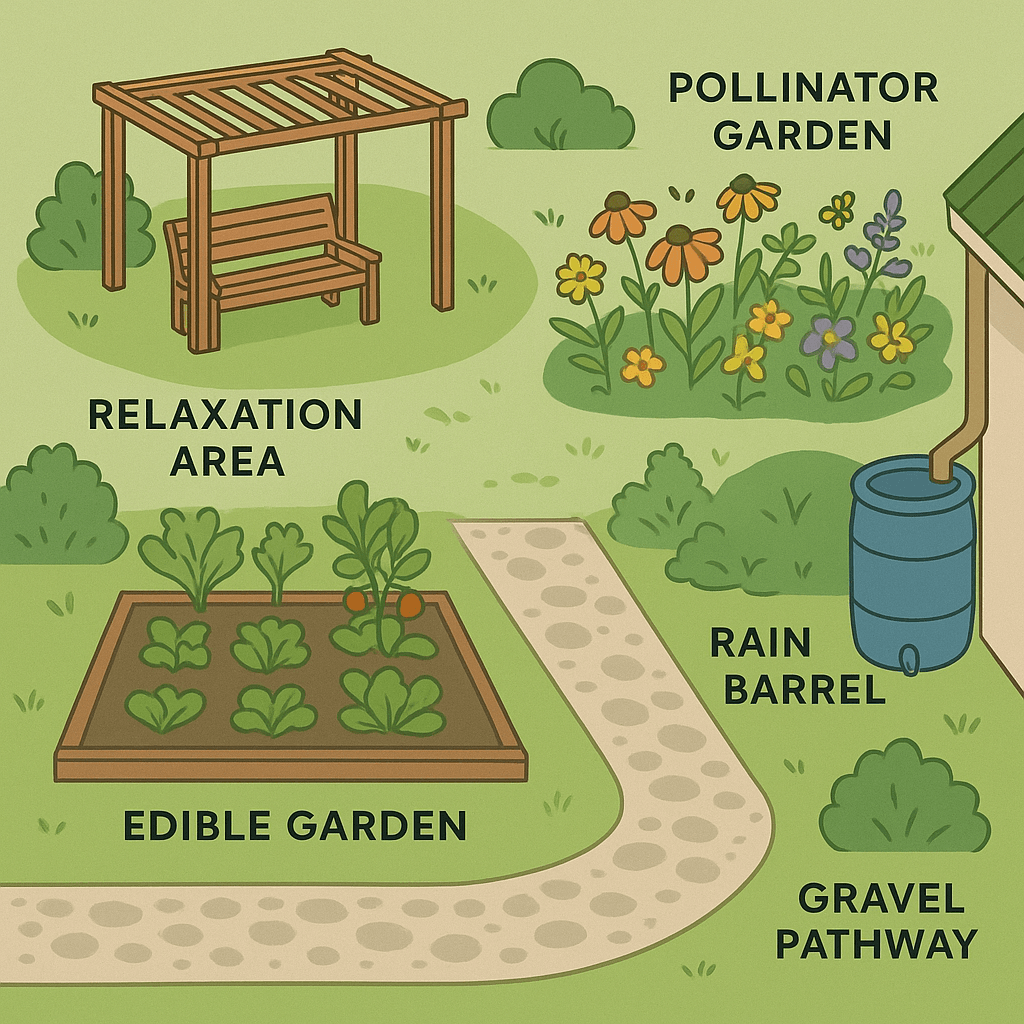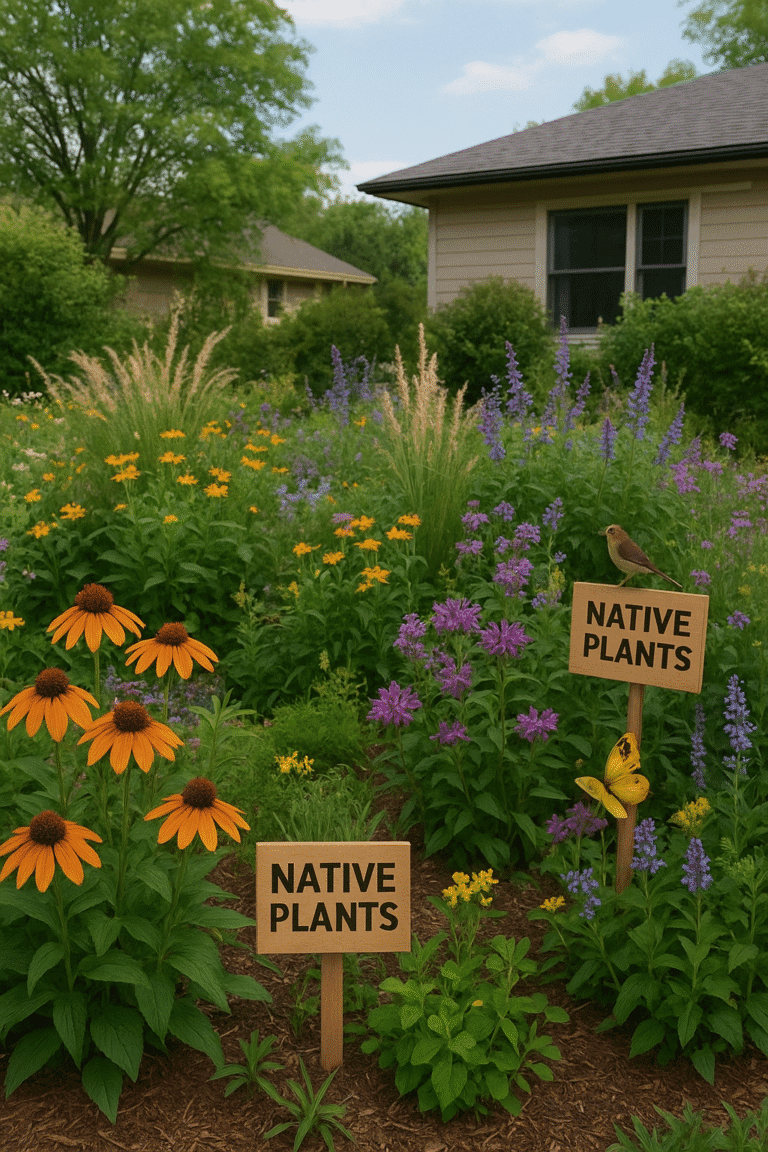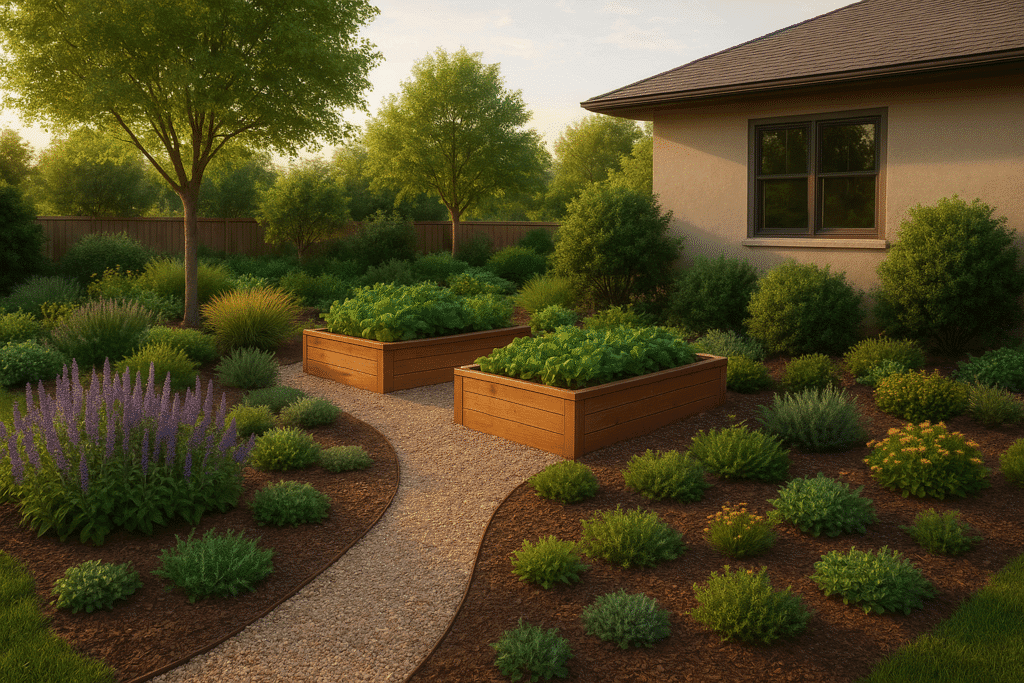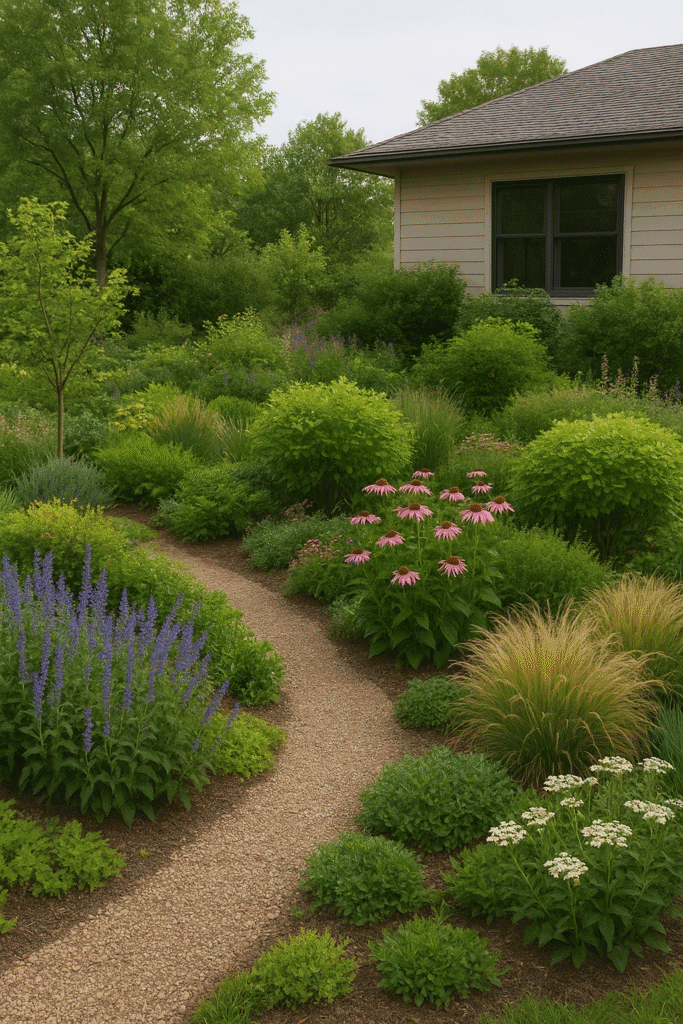
Table of Contents
ToggleWhy eco friendly landscaping ideas matters?
Most of us eco lovers are looking for ways to create a yard that is beautiful, easy to care and good for the planet. For those homeowners who want outdoor spaces that are attractive and practical, the eco friendly landscaping ideas are a perfect choice for them. Instead of battling nature with chemical fertilizers, constant watering and high maintenance, these designs help you to save time, money and resources.
A yard planned with sustainable garden design principles can actually work with the environment rather than being against it. By selecting those plants which can thrive in your climate, improving soil health naturally and adding smart features like rain gardens or permeable pathways you can create a landscape that stays resilient. It reduces stress on local ecosystems and also gives you a greener space that needs far less upkeep.
In fact, many eco friendly yard ideas prove that you don’t need endless mowing for expensive treatment to enjoy a thriving outdoor area. This guide brings together actionable strategies and creative solutions that show how eco friendly landscaping ideas can transform your yard into a low-maintenance climate-smart and eco-conscious retreat.

Eco friendly design principles
When it comes to eco friendly landscaping ideas, the foundation of a thriving & low-maintenance yard is all about design choices. A well-planned layout saves effort and ensures that your outdoor space stays resilient through different seasons.
Work With Nature, Not Against It
The best landscapes don’t fight from their environment. You should always start by studying your yard’s microclimates- notice when areas get full Sun, partial shade or when they tend to stay damp after rain. The first rule of sustainable garden design is to align plants and features with these natural patterns.
Healthy Soil = Healthy Yard
Good soil health reduces the need for synthetic fertilizers. Add compost or organic matter that improves drainage, supports earthworms and helps plants to retain nutrients naturally. Avoid peat-based products and choose local or organic alternatives to protect the global ecosystem.
Smart Zoning for Efficiency
Divide your yard into functional zones such as a relaxation area, edible garden, pollinator corner and a low water section. This not only organizes your space but also makes maintenance easier for you. For example –placing all drought-tolerant plants together simplifies irrigation.
Balance Aesthetics and Ecology
Beauty and sustainability can go hand in hand. Meaning, blending native shrubs with decorative perennials creates vibrant borders that look good the whole year and also attract pollinators. Simple features like permeable walkways and stone seating can also enhance function without harming the environment.
Long-Term Resilience
Resilient design means preparing your yard for the future. Select perennial plants over short-lived plants to reduce planting needs. A strategic free placement can cut cooling costs in summer. These choices together can make your landscape both practical and planet-friendly.
By building on these principles you can create a foundation where every choice (from plant Selection to hardscaping) supports your long-term vision.

Plant Selection and Biodiversity
One of the smartest ways to bring eco friendly landscaping ideas to life is through the perfect plant choices. The right mix will make your yard visually appealing and strengthen the ecosystem around it.
Choose Native Over Exotic
The simplest step toward sustainability is opting for native plant landscaping. Native species thrive naturally in local conditions which means they require less water, fewer fertilizers and minimal upkeep. They also provide food and shelter for pollinators, birds and beneficial insects that keep your garden balanced.
Prioritize Diversity
Monoculture planting (planting a single or 2 types of plants only) often leads to soil depletion and pesticide problems. You should always aim for biodiversity. Combining shrubs, flowering perennials and ground covers creates a multi-layered ecosystem that supports wildlife and reduces maintenance. This variety keeps your yard dynamic across all seasons.
Low-Maintenance Landscaping Ideas
If you’re looking to cut down on upkeep then consider hardy perennials, drought-resistant succulents and ornamental grasses. These plants demand little attention yet they bring texture and colour throughout the year. To ensure your yard is alive even in colder months go with evergreen ways.
Design Pollinator-Friendly Zones
Set a small area which is filled with nectar-rich flowers such as coneflowers, lavender or milkweed. These plants support bees and butterflies while adding a vibrant colour. Add a shallow water dish with stones, which can help beneficial insects and birds.
Reduce Lawn Dependence
Traditional lawns consume large amounts of water and fertilizer. By replacing sections of grass with ground covers, herbicide gardens or wildflower meadows you can cut down on inputs with increasing ecological benefits. This approach will save your time and also enhance resilience.
With the right plants in the right place, you can transform your yard into a living system that’s beautiful, practical and deeply supportive for local biodiversity.
Water Conservation Techniques
The most impactful eco friendly landscaping ideas are those that reduce water waste without sacrificing beauty. Smart irrigation, plant choices and soil management can all keep your yard green. According to the U.S. EPA, inefficiencies in traditional irrigation can cause up to 50% of applied water to be lost through evaporation, wind, runoff, or overapplication.
Embrace Eco-Friendly Yard Ideas for Irrigation
Traditional sprinkler systems often waste gallons of water daily. A smarter approach is installing drip irrigation or soaker hoses which deliver moisture directly to the roots. Pairing this with a rain sensor or smart timer ensures that plants get water only when they’re needed.
Collect and Reuse Rainwater
Rain barrels and underground cisterns are excellent additions to a sustainable garden. They store water during the wet season for later use. This method cut down reliance on municipal supplies. Even a modest barrel connected to your gutter can keep a flower bed thriving through dry spells.
Soil as a Natural Reservoir
Healthy soil acts like a sponge. By adding compost and mulch you can improve its water-holding capacity while reducing evaporation. A simple layer of wood chips or shredded bark around shrubs can keep roots cool and moist for longer periods.
Eco-Friendly Lawn Care Practices
Lawns are often the thirstiest part of any yard. Hence, switch to drought-tolerant grass species or reduce lawn size altogether which can cut water needs. For areas that must remain grassy, mow higher and less frequently to help the soil retain moisture.
Sustainable Landscaping Ideas for a Greener Future
Strategic design like grouping plants with similar water needs maximises efficiency. For example- placing succulents and ornamental grasses in one zone simplifies irrigation. Over time, this approach builds a yard that is both functional and resource-conscious.

Hardscaping and Low-Effort Enhancements
Hardscaping brings structure and durability to your outdoor space and when it is done right, it complements sustainable garden design. Instead of energy-intensive features, choose natural, permeable and long-lasting materials.
Stones, reclaimed wood or recycled bricks are excellent choices for pathways and patios. Permeable pavers are another smart option because they allow rainwater to soak into the soil rather than causing water runoff- that’s what makes them perfect for sustainable garden design.
Adding hardscape features also helps to reduce the amount of traditional lawn or planting space you need to maintain. Gravel beds, raised planters or even a dry creek bed can lower your maintenance work and give you a modern-looking yard. These small shifts are practical examples of low-maintenance landscaping ideas that make life easier.
At the same time, simple structures like a stone bench, birdbath or wooden pergola can bring both charm and functionality. They don’t require constant attention yet they enhance the overall atmosphere of your space. Hardscaping ensures that your yard stays attractive, durable and easy to care for when it’s planned perfectly.
Climate-Smart & Low-Maintenance Design
Designing a yard that naturally adjusts to the local climate is one of the most reliable ways to keep it healthy and stress-free. Choose plants suited to your region then you can automatically cut down the need for extra water, fertilizers or chemical support. This is where native plant landscaping becomes Powerful because native species are already adapted to your soil and weather patterns.
A climate-smart approach also means thinking ahead and planning for the whole year’s interest. Planting evergreens keeps your yard green during the colder months while flowering perennial plants bring color in the summer. Deciduous trees can provide shade in hot weather and allow more sunlight to pass in the winter. These choices create a balanced and resilient outdoor space that looks lively every season.
The beauty of this method is that it automatically reduces the amount of work you need to put in. Raised beds, mulched borders and gravel paths limit mowing and watering. This combination reflects sustainable landscaping ideas that balance beauty, efficiency and care for the environment – all of this with keeping a low maintenance.
FAQs
What are some simple eco-friendly yard ideas for beginners?
Beginners can start small with eco friendly yard ideas such as planting native species, reducing lawn areas, using organic mulch and adding drought tolerant plants. These steps lower water use and cut down on maintenance while supporting biodiversity.
How does native plant landscaping save time and resources?
Native plant landscaping works with your region’s natural climate. Because these plants are already adapted to local soil and rainfall and they need less watering, fertilizers and overall care. This makes them both sustainable and cost-effective compared to non-native species.
Are low maintenance landscaping ideas suitable for small yards?
Yes, low maintenance landscaping ideas are perfect for small spaces. Features like gravel paths, container gardens and eco friendly lawn care alternatives (such as clover or ground covers) create attractive & functional yards without demanding extra effort or resources.
